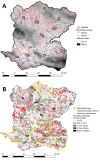Delineating and Analyzing Locality-Level Determinants of Cholera, Haiti
- PMID: 33350917
- PMCID: PMC7774537
- DOI: 10.3201/eid2701.191787
Delineating and Analyzing Locality-Level Determinants of Cholera, Haiti
Abstract
Centre Department, Haiti, was the origin of a major cholera epidemic during 2010-2019. Although no fine-scale spatial delineation is officially available, we aimed to analyze determinants of cholera at the local level and identify priority localities in need of interventions. After estimating the likely boundaries of 1,730 localities by using Voronoi polygons, we mapped 5,322 suspected cholera cases reported during January 2015-September 2016 by locality alongside environmental and socioeconomic variables. A hierarchical clustering on principal components highlighted 2 classes with high cholera risk: localities close to rivers and unimproved water sources (standardized incidence ratio 1.71, 95% CI 1.02-2.87; p = 0.04) and urban localities with markets (standardized incidence ratio 1.69, 95% CI 1.25-2.29; p = 0.0006). Our analyses helped identify and characterize areas where efforts should be focused to reduce vulnerability to cholera and other waterborne diseases; these methods could be used in other contexts.
Keywords: Haiti; Vibrio cholerae O1; bacteria; cholera; communicable disease prevention and control; enteric infections; epidemiology; foodborne infections; risk factors; spatial analysis; waterborne infections.
Figures






References
-
- Ministère Santé Publique et de la Population (MSPP). Department of Epidemiology, Laboratories and Research (DELR). Report of the National Cholera Surveillance Network, 40th epidemiological week 2019. [in French] [cited 2019 Dec 1]. http://mspp.gouv.ht/site/downloads/Profil%20statistique%20Cholera%2040SE...
-
- Republic of Haiti, Ministry of Public Health and Population, National Directorate for Water Supply and Sanitation. National plan for the elimination of cholera in Haiti 2013–2022 [in French] [cited 2019 Dec 1]. https://www.paho.org/hq/index.php?option=com_docman&task=doc_view&gid=20...
-
- Republic of Haiti, Ministry of Public Health and Population, National Directorate for Water Supply and Sanitation. National plan for the elimination of cholera: development of the long term plan 2018–2022 [in French] [cited 2019 Dec 1]. http://mspp.gouv.ht/site/downloads/Plan%20a%20long%20terme%202018%202022...
MeSH terms
LinkOut - more resources
Full Text Sources
Other Literature Sources
Medical

